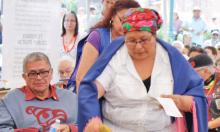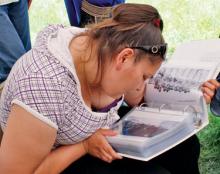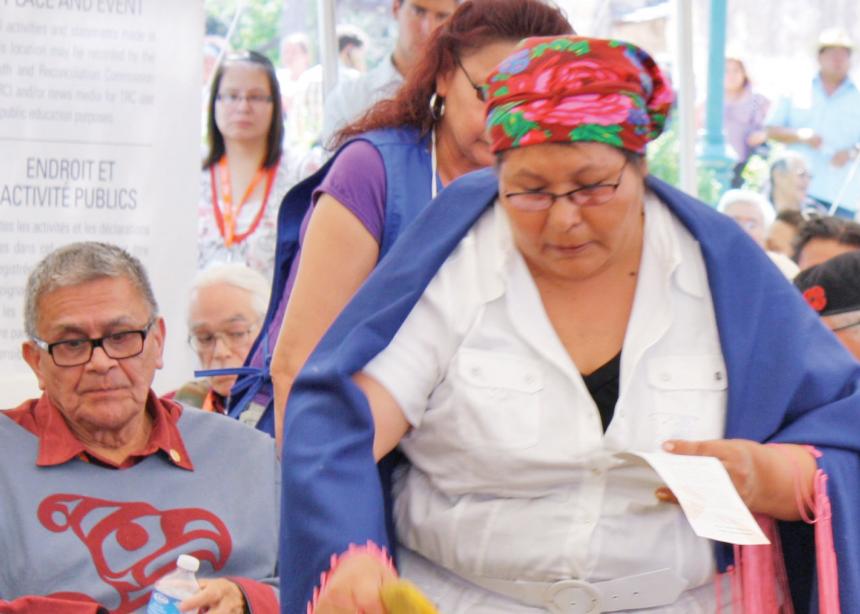As the Truth and Reconciliation Commissioners begin their five-year sojourn across Canada to hear the stories of those who suffered under the Indian Residential School (IRS) system, Mennonites may well ask if or how they should be involved in this process.
It was the Roman Catholic, Anglican, United and Presbyterian churches that entered into a formal partnership in the late 1800s with the federal government to operate these residential schools. Mennonites were not part of this partnership with the government.
The IRS system is a painful chapter in Canadian history that has not been fully told. Tens of thousands of aboriginal children, some only five years old, were forcibly torn away from their families and taken to distant Christian schools. There, Sir Duncan Campbell Scott, head of the Indian Affairs department in the 1920s, mandated the schools to “take the Indian out of the Indian.”
In recent years as some of the stories have come to light, those churches that partnered with the government have made apologies, are seeking reconciliation and engaging in the process of healing, not just because of the physical and sexual abuses that have come to light but also because of their participation in an effort to destroy a people and a way of life.
In 2007, the Indian Residential Schools Settlement Agreement was passed. It was “the largest class action settlement in Canadian history,” writes Larry Plenert, a Mennonite and lawyer in B.C. who has been appointed to work as an adjudicator of claims by survivors of serious abuse at IRS. This agreement, he says, includes three main programs: a “Common Experience Payment” entitling every aboriginal student to financial compensation for the abusive experiences they suffered at IRS; an Independent Assessment Process that resolves claims of sexual or physical abuse suffered at IRS in an out-of-court, alternative dispute resolution process; and a Truth and Reconciliation Commission mandated “to inform all Canadians about what happened in the 150-year history of the residential schools and inspire a process of reconciliation and renewed relationships based on mutual understanding and respect.”
In June 2008, Prime Minister Stephen Harper apologized in Parliament on behalf of Canada to IRS survivors, recognizing “that it was wrong to forcibly remove children from their homes, . . . from rich and vibrant cultures and traditions. . . . You have been working on recovering from this experience for a long time and in a very real sense, we are now joining you on this journey.”
With these provisions in place, some Mennonite voices have joined the sentiments of those expressed in letters to editors and on-line postings: “Enough already, it’s time to move on,” “The best thing to do now is get over it” and “Stirring the pot means it will never settle down.”
Why should Mennonites care? Janet Plenert, executive secretary of Mennonite Church Canada, Christian Witness, says, “We cannot and must not remove ourselves from this tragic and sweeping failure of the church to be the church. We (as Christians) allowed the government to consider Aboriginal Peoples to be second class, and like savages.”
Menno Wiebe, who has worked with the aboriginal community under Mennonite Central Committee and Mennonite Church Canada for 37 years said, “Sadly, the Indian Residential schools were instituted as part and parcel of the church’s mission, a historic reality from which no church can now dissociate itself.”
Mennonite individuals and congregations, within and beyond MC Canada, have been involved in a variety of ways with day schools and children’s homes, observes Plenert. A spokesperson for the Truth and Reconciliation Commission claims that the only Mennonite-run school that was included in the IRSSA (IRS Settlement Agreement) was the Poplar Hill School in Northwestern Ontario. “It is the Commission’s understanding that the denomination which ran it was no longer in existence in Canada in 2007, which may account for it not being included in the settlement agreement. The Commission has come across reports of other (Mennonite) schools that took in aboriginal students, on either a day or residential basis, but is not in a position to comment on why they are or are not part of the agreement.”
“We were late-comers to the scene,” says Wiebe. In 1948, Mennonites began to work in northern Manitoba aboriginal communities under Mennonite Pioneer Mission, which later became Native Ministries.
Henry and Elna Neufeld were among those early workers. They began their teaching ministry in Moose Lake, in northern Manitoba. “The instructions from the inspector were that we get the children to speak English at any cost . . . we soon recognized that pushing English at any cost on these children was beyond our dignity. We strongly encouraged English in the classroom but did not interfere outside. This had been their language for centuries. How could we now insist on them making English their first priority with the ultimate aim of wiping it out, any more than forcing my mother to speak English?”
Whether serving in the school in Little Grand Rapids or starting the school in Pauingassi, Neufeld had many experiences with the authorities that ran counter to his convictions. “I must admit that I tried to comply during the time that any school official was present, but as soon as they were gone I was back to my original vision, to respect the local language in every way possible.” The Neufelds worked hard to become fluent in Saulteaux.
“The many times we had our knuckles rapped back in those days was not a pleasant experience,” says Henry. “However, by God’s grace we were able to stand firm on our position and not let ourselves be taken in with the tide of the time.”
Plenert reflects that “some of our involvements are shining examples of faithful witness and honouring of peoples and cultures created in the image of God. Other activities are now raising questions.”
Wiebe recalls when Mennonites began their involvement in aboriginal ministries, “Mennonites raised some questions—why were they extracting kids from their families and taking them to white teachers?
“As is our Mennonite tradition, the construction of a central school was always part of the building of any village or community. Strong community and family consciousness was part of our mindset. We heard the laments of the Native parents of Bloodvein and Cross Lake when their children were removed. They trusted us.”
Timber Bay Children’s Home, north of Prince Albert in Saskatchewan, was a dormitory for aboriginal students to attend a local public school. The Northern Canadian Evangelical Mission operated it until 1968 when the Brethren in Christ Church took over.
“From 1973–1990 Mennonite Central Committee had volunteers working at the Timber Bay home,” says Leonard Doell, coordinator of MCC Saskatchewan (MCCS) Aboriginal Neighbours program. This spring MCCS hand-delivered a letter with an “invitation to dialogue” to the three communities whose children had lived at Timber Bay. “We want to talk about what that experience has been like,” continues Doell. “Part of the issue for them has been exclusion form the IRSSA. They are looking to be included because their experience at Timber Bay was like that at other residential schools.” Because Timber Bay did not receive federal financial assistance or any government monitoring, it fell through the cracks, explains Doell.
“Our story is very much interconnected and we need to find out more about it,” he says. “During the Second World War, the Mennonite Church and the United Church in Manitoba entered an agreement in which Mennonite conscientious objectors worked as teachers and pastors in United Church-run residential schools while their young men went off to war. We need to find out more about our involvement and encourage our people and churches to participate.”
The MCCS office is involved in a training process for its staff to “develop some listening skills. How do we inform ourselves of the wider IRS story? How can we hear the anger and where do we go from here? How do we prepare to be better neighbours?” are some of the questions that training seeks to address.
As Wiebe continues to be in contact with aboriginal communities across the country, he is aware of the presence of Mennonites in these communities. “Nursing stations and local schools, everywhere I find Mennonites. I know of medical doctors training to go north. Now please, please learn something about the culture,” he pleads.
Since the middle of last century the Mennonite Church has been actively involved with aboriginal communities. While the Mennonite experience has been different from that of the Catholic, Anglican, Presbyterian and United Churches, it has contributed to the perpetuation of negative attitudes toward and perceptions of native people. “There is perhaps no more significant, pervasive, broad-based need for reconciliation than there is between the Aboriginal Peoples and those of us who came and claimed their land and legally and officially pronounced them savages in need of saving and civilizing,” confesses Janet Plenert.
Larry Plenert recently wrote that he hopes “my fellow Canadian Mennonites [will] commit themselves to learning the truth about a sad and misguided chapter of our country’s history and . . . that discernment can occur as to how we best apply principles of justice, restoration and reconciliation in the context of our ongoing relationship with our aboriginal Canadian neighbours.”
The Truth and Reconciliation Commission is giving Mennonites that opportunity to be part of a healing process, an opportunity to acknowledge misguided efforts, and an opportunity to learn more about how to be in a just and restorative relationship with aboriginal neighbours.
The Commission’s first public event at The Forks in Winnipeg on June 16-19 drew an estimated 40,000 people. “We come together in the spirit of healing and community, to stand at The Forks, on sacred ground, to acknowledge those who have lived their lives in the shadow of the Indian Residential School System—the students, the staff, their families and the citizens of this country—and to bear witness to their stories,” said Justice Murray Sinclair, chair of the Commission.
Throughout the four days, stories that took immeasurable courage to tell unfolded. The stories told of pain, betrayal, abuse, forced separation from families and how this painful legacy extends beyond the survivors to their families, communities and successive generations. But the stories also spoke of resilient strength and faith.
Wiebe insists that one of the important steps in our reconciliation is education. “Mennonite learning institutes need to include an upgraded understanding of Aboriginal peoples, culture and societies. Mennonites might well undertake some leadership in advancing cultural orientations for teachers, social workers, medical staff, economic development and religious workers entering native communities.” He also sees a need for Mennonites to make room for aboriginal art and music.
Larry Plenert hopes that out of the learning and accepting of the truth of this painful chapter, “we will look for ways to eliminate attitudes of colonialism, oppression and inequality that allowed IRS to exist.”
Mennonite Central Committee Canada has created a tool to help us in that process. MCC recently launched a new website www.mythperceptions.ca that debunks the myths, stereotypes and other falsehoods about Canada’s Aboriginal peoples. Sue Eagle, who together with her husband, Harley, directs MCC Canada’s Indigenous Work program, said, “As we hear the stories and unpack the myths, maybe we can begin to build a more accurate understanding of our aboriginal neighbors.”
Mennonite Church Canada is encouraging active participation in the Truth and Reconciliation events offered by the Commission. There will be six more major events across Canada in the next five years. “As Mennonite Church Canada, we would like to have Mennonites active and present at every event,” says Janet Plenert. “Symbolically and practically we will open ourselves to listen deeply, cry at pain and injustice that government policy and racism have caused, and find ways to stand together, pressing onward toward reconciliation and healing. As a church, we can do no less.”
Plans are underway for the next gathering of the Truth and Reconciliation Commission to be held in Inuvik, NWT, in June 2011. “Seven generations of damage cannot be repaired in four days, but the journey we began in Winnipeg has affirmed for us that we have made a good start,” said Marie Wilson, one of the TRC Commissioners.
See other stories related to the 2010 Truth and Reconciliation Commission events:
“With God, all things are possible”- A residential school survivor recalls childhood abuse and his quest to forgive his tormentors.
“A first step toward healing”- A personal reflection on the first TRC events, held in June 2010
“MC Canada shares the pain of Indian Residential School legacy”- A report on discussions at Mennonite Church Canada Assembly 2010
“Poplar Hill’s closure remembered”- Some history on the only Mennonite-affiliated school
“Mennonite treaty rights”- The implications of Treaty 1
“Forgiveness to what end?” An editorial on accepting and offering forgiveness
“For discussion: August 23, 2010 issue”- Questions for reflecting and discussing

Leann Sleigh, painfully sharing how three generations of residential school forced family separation, sexual and physical abuse leading to alcoholism and parental abuse, offers her moccasins to a collection of native artifacts “for those who walked before us.” A read cedar box holding artifacts and documents was commissioned by the TRC as a “lasting tribute” to school survivors. (Photo by Evelyn Rempel Petkau)

In the Learning Tent at The Forks, Jamie Monkman was one of the many poring over photo albums of class pictures from many of the Indian Residential Schools. “I am looking for pictures of my mom and granny, who went to the Norway House school,” she explained. The Learning Tent outlined the history of the Indian Residential Schools with phot displays and historical accounts. (Photo by Evelyn Rempel Petkau)



Comments
I am by nature inclined to skepticism, and so when I hear about the abuses of residential schools I cannot but wonder if there is another side to the story which is not being heard. Mennonites, judging by several recent references, seem to be assuming that any involvement in them at any time makes them guilty of wrong doing. I note that the above article gives no examples of Mennonites actually abusing native children. While there is no doubt that the philosophy behind the residential school movement was wrong it does not follow that they were always bad places for children. I recently spoke to an aging native woman who told me that the three years she spent in a residential school ( no Mennonite connection ) back in the 1960's were the best years of her life. I also heard a similar story from a colleague recently. These stories never seem to make it into the popular press.
Thank you for this observation. Perhaps we have mistaken the TRC testimony as history. It is a record of individuals who had specific experiences and there is no reason to question their factuality. It is a memoir. What is still required in Canada is an evaluation of the government policies that led to the founding of the residential school system, the rationale for why denominations collaborated with government policy—which seems to have had popular support—and a careful examination of government actions as they initiated and administered this program.
Anne Applebaum's work on the Gulag may be a helpful parallel. Her careful assessment of the history, changing policies and administration gives us a helpful understanding of that terrible chapter in Soviet Russia. Canada still awaits that kind of careful, clear-eyed treatment of the residential school saga.
Is there anyone who might be willing to engage in a dialogue with me?
I am a descendant of Mennonite settlers on the Haldimand Tract (Waterloo, Ont.) and I am seeking to fully understand the role of my ancestors in this story. I am embarking on the creation of a social enterprise that is founded in the values of non-violence and reconciliation with my Indigenous sisters. It is so important that I hear from well-informed Mennonites about this story.
Thank you for any support you can offer me!
Hello Andrea. I encourage you to contact Steve Heinrichs, director of Indigenous-Settler relations at Mennonite Church Canada: http://home.mennonitechurch.ca/staff/sheinrichs
Aaron Epp
Online Media Manager, Canadian Mennonite
Andrea: You may want to check out a recent paper published in the Mennonite Quarterly Review 2019 by Anthony Siegrist, the lead minister at the Ottawa Mennonite Church. It is entitled, "'Part of the Authority Structure': An Organizational History of Mennonite Indian Residential Schools in Ontario."
Although it's all hindsight and we can only go forward, I think we must question the very origins of European claiming, conquering, colonizing and development of the Americas, and the role that settlers played.
Often desperate, as in the case of many Russian Mennonites, it's no wonder that settlers came in droves, with gratitude and eagerness, to these places of peace, free land and abundant opportunity. However, they also came without questioning. Global history is full of powerful people taking from one group of poor people and giving to another. The presumptuousness, arrogance, violence and short-sightedness of European overlords is the basis of the settler and the Mennonite presence here.
Residential school abuse is just one more chapter in a 500 year tale of injustice, death and abuse. Yes, some good things have also transpired during that time period, during that clash of cultures, but if we get beyond naive, sanitized, schoolbook versions, it was nothing short of genocide, overall.
So, I question whether Mennonites should have come here at all. We can't go back now, of course, but it seems we could have conscientiously objected to the circumstances by which all this opportunity came about and perhaps stayed in Europe to do the best we could there. The Americas weren't the only escape from Russia.
A deeper assumption underlies residential school abuse, an assumption that European colonizing of the Americas was alright, or at least acceptable, and that settlers and Natives should more or less just go with the flow. It may have been unavoidable, given prevailing mentalities, but that's far different than being acceptable and good.
In any case, we can only learn from the past. I was not a European invader, nor was I an early settler. I was born here and we must all learn to get along, somehow.
We can only go forward, but I like the humility of people who question why we are even here in the first place. It helps put things in perspective. It gives us a better basis by which to debate specific issues, like residential schools. In fact, I'd say that this sort of humility and deeper questioning is integral to truth, reconciliation and growth.
I'm an optimist and I believe in forgiveness, but I don't think glossing over history helps matters. If we grasp it more firmly, we will better grasp present solutions and progress.
Add new comment
Canadian Mennonite invites comments and encourages constructive discussion about our content. Actual full names (first and last) are required. Comments are moderated and may be edited. They will not appear online until approved and will be posted during business hours. Some comments may be reproduced in print.